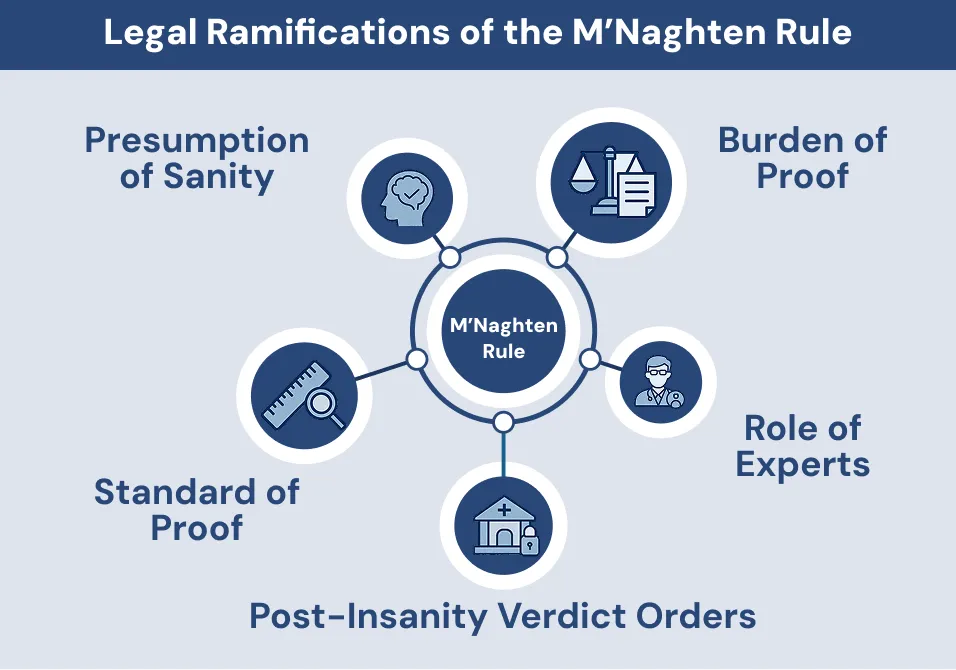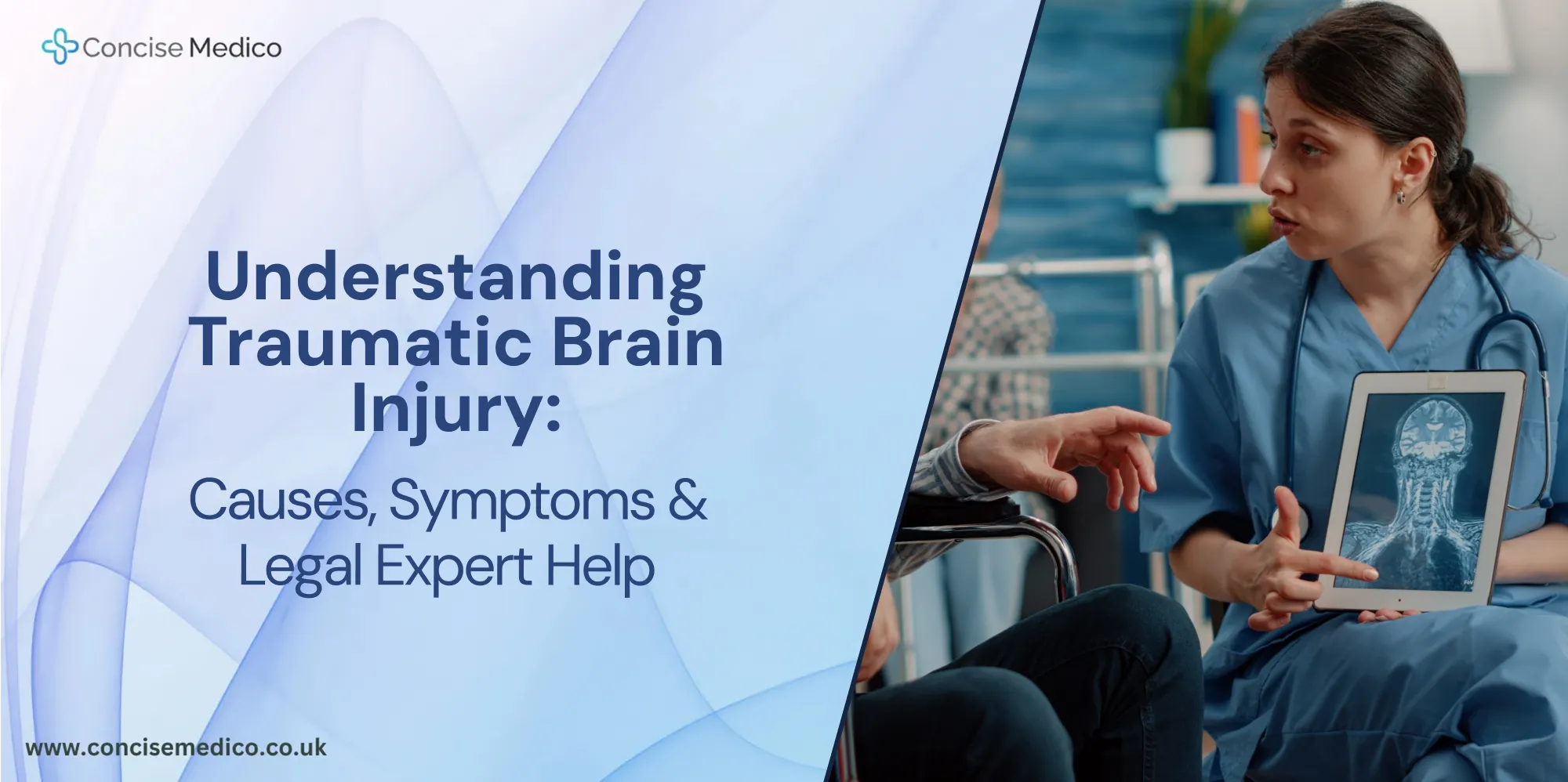The M’Naghten rule is the oldest test for legal insanity. It allows the courts to decide if a person is responsible for a crime. This rule began with a shocking case in 1843 in the UK. It led to the well-known m’naghten rules 1843, still used in many courts today.
In England and Wales, the insanity defence is invoked in fewer than 1% of all criminal cases. In these cases, defendants were not guilty due to insanity. This shows how rare and strict the M’Naghten rules are in today’s courts.
Who Was Daniel M’Naghten?
The M’Naghten Trial (1843) Case
Daniel McNaughton was a woodcutter in Scotland. He shot Edward Drummond in 1843, about which he wrongly believed that he was a political threat. The court accepted the evidence. The jury returned a verdict of “not guilty by reason of insanity.” The judges then set out the M’Naghten Rule which says a defendant must understand their act and know it is wrong to be held responsible.
- Did he understand what he was doing at the time?
- Did he grasp the nature and quality of his act?
- Did he know his act was wrong?
- Did he appreciate the consequences of his action?
- Was his judgment clouded by a delusion?
These questions became the legal test for insanity and still guide UK courts today. Psychiatric experts use them to shape reports and help judges decide if someone was too ill to face blame.
Core of the M’Naghten Rules
These five questions form the core of the rule and guide courts in deciding legal insanity.
1. Was the defendant laboring under a “defect of reason” from a “disease of the mind”?
This checks if a mental illness was so severe that it stopped the person from thinking clearly.
2. Did the defendant know the nature and quality of the act?
This asks whether they understood exactly what they were doing physically.
3. Did the defendant know that the act was wrong?
This looks at whether they grasped that their action was against the law or morally wrong.
4. If the defendant knew the nature and quality of the act, did they know that it was wrong?
This is the important point: if they knew what they did, did they also know why it was wrong?

5. If the defendant did not understand the wrongfulness of the act, is that sufficient to prove legal insanity?
This asks whether not knowing the act was wrong, because of mental illness, should excuse them from blame.
If the answer is “no” to the last two, they may be found not guilty by reason of insanity.
How Courts Use the M’Naghten Rule Today
Modern courts still follow the five M’Naghten rule 1843 questions to decide if a defendant was legally insane. At trial, psychiatrists and psychologists give reports on the defendant’s mind at the time of the act. Judges and juries use these reports to see if a defect of reason truly restricts the person from understanding what they were doing and that it was wrong. If the court finds this proof, the verdict can be found not guilty by reason of insanity, and the defendant is sent for treatment instead of prison.
What Is the M’Naghten Rule Based On
The M’Naghten rules 1843 are legal, not medical. A person may seem healthy but still meet the rule’s criteria. Even if doctors say the person is sane, a court can find legal insanity based on the test.
Legal Ramifications of the M’Naghten Rule
Since 1843, this rule has guided courts on when a defendant’s mental state removes their criminal responsibility. This rule shaped the law in many ways. It introduced key legal ideas that are still relevant today:
Presumption of Sanity
The court starts by assuming the defendant was sane when the act took place. This means mental illness is not raised unless clear evidence shows otherwise. It prevents needless delays for every case.
Burden of Proof
It is the duty on the defense to prove the defendant was legally insane at the time. They must use medical reports and expert testimony to back their claim. Without this proof, the court treats the accused as fully responsible.
Role of Experts
Only qualified doctors or psychologists can testify about a person’s mental state. They examine the defendant, review records, and present clear findings. Judges and juries rely on their reports to decide on sanity issues.

Standard of Proof
Defendants must show insanity on a “balance of probabilities.” This means it is more likely than not that they met the legal test. It is a less stringent test than proving guilt beyond a reasonable doubt.
Post-Insanity Verdict Orders
If a person is absolved on the grounds of insanity, they are not just set free.The court can enact an order under the Insanity Act 1964 or the Mental Health Act 1983:
1. Hospital Order
Detention in a secure psychiatric hospital.
The court’s statutory authority to impose a hospital order is contained in the following provisions:
“The court shall make an order that the accused be admitted to such a hospital as may be specified by the Secretary of State.”
Criminal Procedure (Insanity) Act 1964, s 5(1)
“Where a person is convicted before the Crown Court of an offence punishable with imprisonment … the court may by order authorise his admission to and detention in such hospital as may be specified in the order”
Mental Health Act 1983, s 37(1)
2. Supervision Order
You check in regularly with a probation or mental health officer. You follow treatment plans and report any problems.
3. Absolute Discharge
It applies only when there is no risk to anyone. You face no further conditions and can return to normal life immediately.
These options aim to keep the public safe and support individual care. This shows that the rule is not just about guilt but also about future safety and care.
M’Naghten vs. Other Insanity Tests
Other countries use different tests:
Durham Rule
You are not guilty if your crime was caused by a mental illness. This rule looks at whether the illness led directly to your actions.
ALI Test
Part of the Model Penal Code. It checks if the person lacked the ability to follow the law or understand the act.
The m’naghten rules 1843 does not ask if a person could control their actions. That’s one of the main criticisms of the rule.
Read more details in this blog: Insanity Defense
Criticism of the M’Naghten Rule
Before discussing its cons, it’s worth noting that many experts feel the M’Naghten Rule no longer reflects today’s understanding of mental illness. The rule has several limits:
- It is old and may not match modern mental health knowledge.
- It overlooks if a person can prevent their own actions.
- It can be harsh on people with emotional or cognitive disorders.
- It creates a conflict between legal and medical views.
Reforms Suggested by Experts
Many medicolegal experts want updates. They ask for a “volitional test,” which means checking if the person had control over their actions. Others say courts should consider more mental health conditions. Still, UK courts continue to use the m’naghten rules 1843 as the standard.
Why the Rule Still Matters
This rule sets a high legal bar. It protects society from false claims. It also gives real protection to people with serious mental illness. It asks:
- Was the person aware of what they were doing?
- Did they know it was wrong?
These questions help courts find a balance between justice and health.
The Ongoing Relevance of the Rule
The m’naghten rules 1843 still plays a major role in the UK legal system. Despite its age, it helps decide when mental illness can excuse a crime. It is not perfect, but it creates a clear line in law.
Need expert support with medico-legal reports or court assessments?
Let Concise Medico help you. We provide quick, clear, and court-ready psychiatric evaluations and legal reports.
FAQs
The M’Naghten rule is the oldest test for legal insanity. It allows the courts to decide if a person is responsible for a crime. This rule began with a shocking case in 1843 in the UK. It led to the well-known m’naghten rules 1843, still used in many courts today.
In England and Wales, the insanity defence is invoked in fewer than 1% of all criminal cases. In these cases, defendants were not guilty due to insanity. This shows how rare and strict the M’Naghten rules are in today’s courts.
Who Was Daniel M’Naghten?
The M’Naghten Trial (1843) Case
Daniel McNaughton was a woodcutter in Scotland. He shot Edward Drummond in 1843, about which he wrongly believed that he was a political threat. The court accepted the evidence. The jury returned a verdict of “not guilty by reason of insanity.” The judges then set out the M’Naghten Rule which says a defendant must understand their act and know it is wrong to be held responsible.
- Did he understand what he was doing at the time?
- Did he grasp the nature and quality of his act?
- Did he know his act was wrong?
- Did he appreciate the consequences of his action?
- Was his judgment clouded by a delusion?
These questions became the legal test for insanity and still guide UK courts today. Psychiatric experts use them to shape reports and help judges decide if someone was too ill to face blame.
Core of the M’Naghten Rules
These five questions form the core of the rule and guide courts in deciding legal insanity.
1. Was the defendant laboring under a “defect of reason” from a “disease of the mind”?
This checks if a mental illness was so severe that it stopped the person from thinking clearly.
2. Did the defendant know the nature and quality of the act?
This asks whether they understood exactly what they were doing physically.
3. Did the defendant know that the act was wrong?
This looks at whether they grasped that their action was against the law or morally wrong.
4. If the defendant knew the nature and quality of the act, did they know that it was wrong?
This is the important point: if they knew what they did, did they also know why it was wrong?

5. If the defendant did not understand the wrongfulness of the act, is that sufficient to prove legal insanity?
This asks whether not knowing the act was wrong, because of mental illness, should excuse them from blame.
If the answer is “no” to the last two, they may be found not guilty by reason of insanity.
How Courts Use the M’Naghten Rule Today
Modern courts still follow the five M’Naghten rule 1843 questions to decide if a defendant was legally insane. At trial, psychiatrists and psychologists give reports on the defendant’s mind at the time of the act. Judges and juries use these reports to see if a defect of reason truly restricts the person from understanding what they were doing and that it was wrong. If the court finds this proof, the verdict can be found not guilty by reason of insanity, and the defendant is sent for treatment instead of prison.
What Is the M’Naghten Rule Based On
The M’Naghten rules 1843 are legal, not medical. A person may seem healthy but still meet the rule’s criteria. Even if doctors say the person is sane, a court can find legal insanity based on the test.
Legal Ramifications of the M’Naghten Rule
Since 1843, this rule has guided courts on when a defendant’s mental state removes their criminal responsibility. This rule shaped the law in many ways. It introduced key legal ideas that are still relevant today:
Presumption of Sanity
The court starts by assuming the defendant was sane when the act took place. This means mental illness is not raised unless clear evidence shows otherwise. It prevents needless delays for every case.
Burden of Proof
It is the duty on the defense to prove the defendant was legally insane at the time. They must use medical reports and expert testimony to back their claim. Without this proof, the court treats the accused as fully responsible.
Role of Experts
Only qualified doctors or psychologists can testify about a person’s mental state. They examine the defendant, review records, and present clear findings. Judges and juries rely on their reports to decide on sanity issues.

Standard of Proof
Defendants must show insanity on a “balance of probabilities.” This means it is more likely than not that they met the legal test. It is a less stringent test than proving guilt beyond a reasonable doubt.
Post-Insanity Verdict Orders
If a person is absolved on the grounds of insanity, they are not just set free.The court can enact an order under the Insanity Act 1964 or the Mental Health Act 1983:
1. Hospital Order
Detention in a secure psychiatric hospital.
The court’s statutory authority to impose a hospital order is contained in the following provisions:
“The court shall make an order that the accused be admitted to such a hospital as may be specified by the Secretary of State.”
Criminal Procedure (Insanity) Act 1964, s 5(1)
“Where a person is convicted before the Crown Court of an offence punishable with imprisonment … the court may by order authorise his admission to and detention in such hospital as may be specified in the order”
Mental Health Act 1983, s 37(1)
2. Supervision Order
You check in regularly with a probation or mental health officer. You follow treatment plans and report any problems.
3. Absolute Discharge
It applies only when there is no risk to anyone. You face no further conditions and can return to normal life immediately.
These options aim to keep the public safe and support individual care. This shows that the rule is not just about guilt but also about future safety and care.
M’Naghten vs. Other Insanity Tests
Other countries use different tests:
Durham Rule
You are not guilty if your crime was caused by a mental illness. This rule looks at whether the illness led directly to your actions.
ALI Test
Part of the Model Penal Code. It checks if the person lacked the ability to follow the law or understand the act.
The m’naghten rules 1843 does not ask if a person could control their actions. That’s one of the main criticisms of the rule.
Read more details in this blog: Insanity Defense
Criticism of the M’Naghten Rule
Before discussing its cons, it’s worth noting that many experts feel the M’Naghten Rule no longer reflects today’s understanding of mental illness. The rule has several limits:
- It is old and may not match modern mental health knowledge.
- It overlooks if a person can prevent their own actions.
- It can be harsh on people with emotional or cognitive disorders.
- It creates a conflict between legal and medical views.
Reforms Suggested by Experts
Many medicolegal experts want updates. They ask for a “volitional test,” which means checking if the person had control over their actions. Others say courts should consider more mental health conditions. Still, UK courts continue to use the m’naghten rules 1843 as the standard.
Why the Rule Still Matters
This rule sets a high legal bar. It protects society from false claims. It also gives real protection to people with serious mental illness. It asks:
- Was the person aware of what they were doing?
- Did they know it was wrong?
These questions help courts find a balance between justice and health.
The Ongoing Relevance of the Rule
The m’naghten rules 1843 still plays a major role in the UK legal system. Despite its age, it helps decide when mental illness can excuse a crime. It is not perfect, but it creates a clear line in law.
Need expert support with medico-legal reports or court assessments?
Let Concise Medico help you. We provide quick, clear, and court-ready psychiatric evaluations and legal reports.




